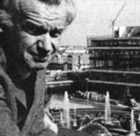The architect Peter Celsing
In 1998, when Stockholm was European City of Culture, Peter Celsing’s architecture was the focal point. It was he that gave a face to the new city of the prosperous post-war era.
 Peter Celsing was born in 1920. He was an architect and professor at the Swedish Royal Institute of Technology and had previously studied at the Royal Swedish Academy of Fine Arts. Following graduation, he began his architectural career in Beirut.
Peter Celsing was born in 1920. He was an architect and professor at the Swedish Royal Institute of Technology and had previously studied at the Royal Swedish Academy of Fine Arts. Following graduation, he began his architectural career in Beirut.
On his return to Sweden, Celsing was appointed chief architect at Stockholms Spårvägar (now Stockholm Transport), where he became involved in the planning of Underground stations for Stockholm's suburbs. In the 1950s, he designed the churches in Härlanda in Gothenburg, Almtuna in Uppsala, and Vällingby in Stockholm.
In the 1960s, Celsing restored the university library Carolina Rediviva in Uppsala, the buildings of the Swedish Steel Producers' Association, as well as the Royal Opera House and the Operakällaren restaurant in Kungsträdgården in Stockholm. He also won two Nordic competitions, which resulted in the Filmhuset building in Gärdet and Sergels Torg including Kulturhuset. The new Riksbank building at Brunkebergstorg proved to be his last project. Peter Celsing died on 16 March 1974. His final days as an architect were spent working on the top floor of the Riksbank, where he recreated "the old attics of his childhood".
Thanks for your feedback!
Your comment could not be sent, please try again later

Questions? Visit our FAQ on kundo.se (opens i new window).